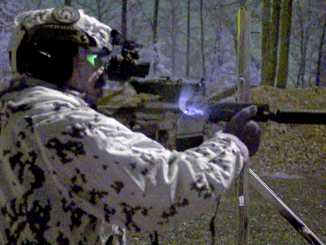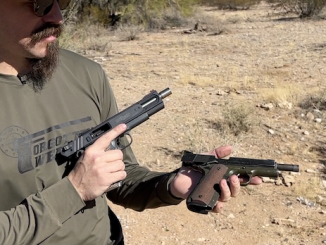The Remington Rolling Block was one of the most widely successful and popular military rifles of the late 1800s, and its development began with the Remington Split Breech carbine during the American Civil War. The concept was independently conceived by two different engineers – one was Leonard Geiger, and the other was Joseph Rider – an engineer working for the Remington firm. When the guns went into production, Remington agreed to a royalty deal with Geiger (and his partner, Charles Alger) to avoid any potential patent lawsuits.
The system is a clever and compact design in which the hammer acts as a lock to hold the rotating breechblock in place when fired, and it would prove capable of use not just with black powder cartridges but also after the widespread adoption of high powered smokeless power ammunition. However, when Remington first demonstrated it to the US Ordnance Department during the war, they did not have the production capacity to actually make a large number. Instead, the gave that authority to a Mr. Samuel Norris, who was able to obtain contracts for 20,000 of the guns (5,000 in .44 Rimfire and 15,000 in .56-50 Spencer rimfire), and contract their manufacture to the Savage Revolving Fire Arms Company. These guns would all be delivered to the Federal government, but not in time to see any use during the war.
Instead, they were put into storage, and soon sold off as surplus. Virtually all of them were repurchased by Remington and a few other surplus brokers and resold to France in 1870, when the French were desperate for arms to replace their huge losses in the Franco-Prussian War.




Remington’s agreement with the development guys is a good reminder that firms should cover their bases and remember to give credit where it is due. Sadly, such gentlemanly behavior was not found in Rollin White, whose constant patent suits (over something that was already patented by another firm) stymied revolver development. How the US Patent office allowed such tomfoolery to continue for over half a century is beyond my knowledge (unless we count money under the table)…
“Rollin White”
Patent trolls are sadly not only matter of past, although much less vicious, there is one example: https://patents.google.com/patent/US5443036A/en
while I am not aware of any monetary gain for owner of this patent after lawsuit, it ridicule U.S. Patent Office (existing prior-art anyone?)
Regarding more recent patent held by Amazon:
https://www.theverge.com/2018/3/22/17150868/amazon-drone-patent-delivery-wave-speech-recognition
I have doubt about it (possibly: combination of existing solutions).
Regarding wonky patents see also 87 U.S. 498
https://en.wikipedia.org/wiki/87_U.S._498
Also a Canadian military arm. A small number were purchased by the Montreal Guides Regt during the Fenian Raids 1866-70.
Magnificent condition!
What a story, what samples…. magnificent. Ian’s at his best!
Is there any provenance for either of these guns? There has never been a link I can follow to either auction house for their catalogue description; hence my need to ask..
Probably a hydrogen balloon?
Ust from looking it appears you could easily convert either to center fire
No it was a hot air ballon
Actually there were 2 of the large frame rifles for sale at Neuvic gun show last year The price was I believe around 1200 euroes each
I have been going to gun shows here in south west france since 1984 and although remington rolling blocks in .43/44 or 11mm egyptian are common these were the first split breeches I have ever seen
In fact there were so many people in front of the stand that I had to wait till 1 oclock(french lunch hour) to see them
If I remember correctly, Spencer’s manufacturer went bust, Winchester bought out their stock and manufactory, then sold all the Spencer rifles and carbines to France and converted the machinery to make Henry-Winchesters. Thus they removed both the Spencer gun and the Spencer system from competition. Meanwhile, Christopher Spencer himself made his fortune on a screw-cutting machine. And the French had their first batch of weapons in .56-50.
In fact there are so many spencers in france that in the 1970’s somebody was making centre fire breech block conversions for them